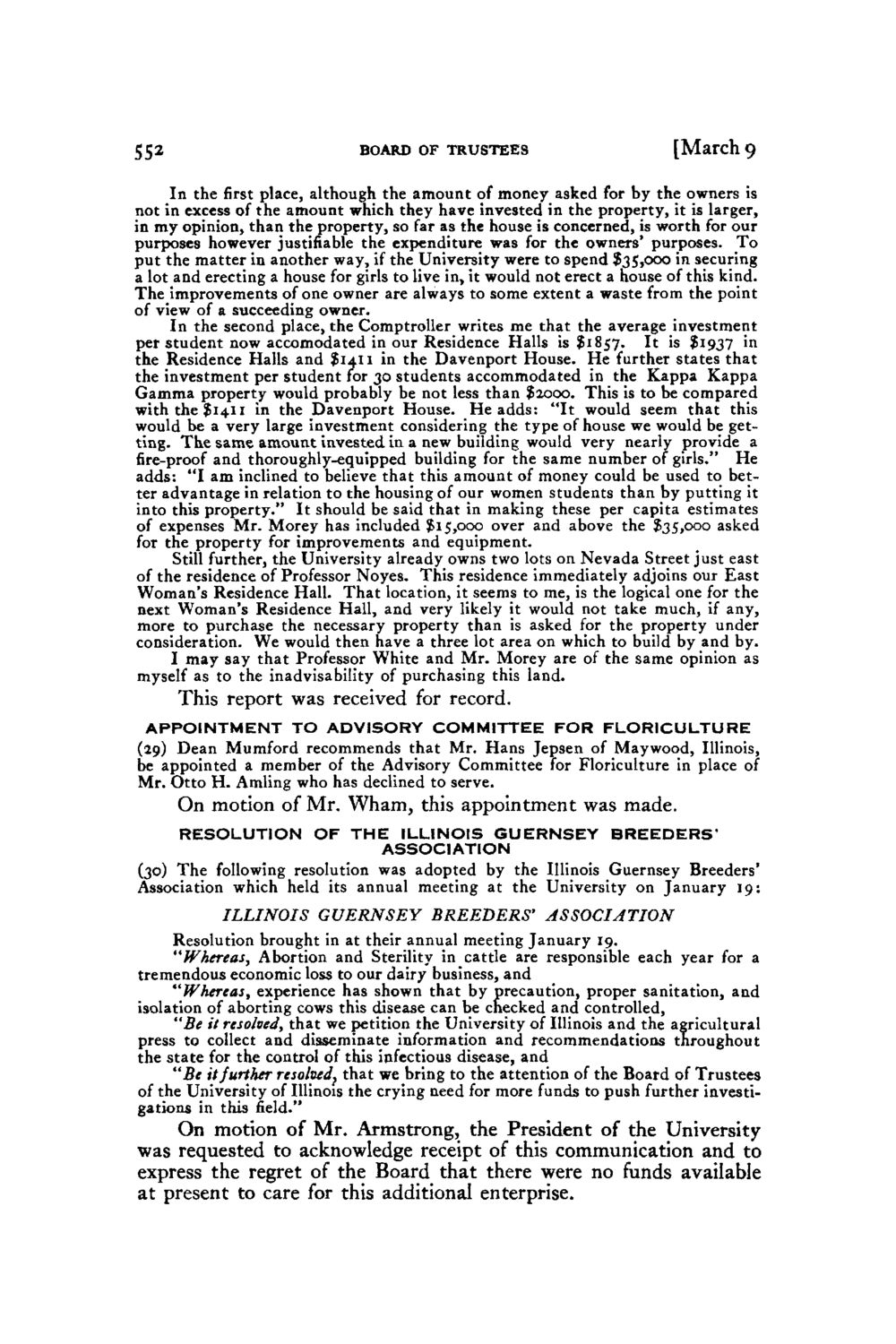| |
| |
Caption: Board of Trustees Minutes - 1926
This is a reduced-resolution page image for fast online browsing.

EXTRACTED TEXT FROM PAGE:
552 BOARD OF TRUSTEES [March 9 In the first place, although the amount of money asked for by the owners is not in excess of the amount which they have invested in the property, it is larger, in m y opinion, than the property, so far as the house is concerned, is worth for our purposes however justifiable the expenditure was for the owners' purposes. T o put the matter in another way, if the University were to spend $35,000 in securing a lot and erecting a house for girls to live in, it would not erect a house of this kind. The improvements of one owner are always to some extent a waste from the point of view of a succeeding owner. In the second place, the Comptroller writes m e that the average investment per student now accomodated in our Residence Halls is $1857. It is $1937 in the Residence Halls and $1411 in the Davenport House. H e further states that the investment per student for 30 students accommodated in the Kappa Kappa G a m m a property would probably be not less than $2000. This is to be compared with the $1411 in the Davenport House. H e adds: "It would seem that this would be a very large investment considering the type of house w e would be getting. The same amount invested in a new building would very nearly provide a fire-proof and thoroughly-equipped building for the same number of girls." H e adds: "I a m inclined to believe that this amount of money could be used to better advantage in relation to the housing of our women students than by putting it into this property." It should be said that in making these per capita estimates of expenses Mr. Morey has included $ 15,000 over and above the $35,000 asked for the property for improvements and equipment. Still further, the University already owns two lots on Nevada Street just east of the residence of Professor Noyes. This residence immediately adjoins our East Woman's Residence Hall. That location, it seems to me, is the logical one for the next Woman's Residence Hall, and very likely it would not take much, if any, more to purchase the necessary property than is asked for the property under consideration. W e would then have a three lot area on which to build by and by. I m a y say that Professor White and Mr. Morey are of the same opinion as myself as to the inadvisability of purchasing this land. This report w a s received for record. APPOINTMENT TO ADVISORY COMMITTEE FOR FLORICULTURE (29) Dean Mumford recommends that Mr. Hans Jepsen of Maywood, Illinois, be appointed a member of the Advisory Committee for Floriculture in place of Mr. Otto H. Amling who has declined to serve. O n motion of M r . W h a m , this appointment was made. RESOLUTION OF THE ILLINOIS GUERNSEY BREEDERS' ASSOCIATION (30) The following resolution was adopted by the Illinois Guernsey Breeders' Association which held its annual meeting at the University on January 19: ILLINOIS GUERNSEY BREEDERS' ASSOCIATION Resolution brought in at their annual meeting January 19. "Whereas, Abortion and Sterility in cattle are responsible each year for a tremendous economic loss to our dairy business, and "Whereas, experience has shown that by precaution, proper sanitation, and isolation of aborting cows this disease can be checked and controlled, "Be it resolved, that we petition the University of Illinois and the agricultural press to collect and disseminate information and recommendations throughout the state for the control of this infectious disease, and "Be it further resolved^ that we bring to the attention of the Board of Trustees of the University of Illinois the crying need for more funds to push further investigations in this field." O n motion of M r . Armstrong, the President of the University w a s requested to acknowledge receipt of this communication a n d to express the regret of the B o a r d that there were n o funds available at present to care for this additional enterprise.
| |